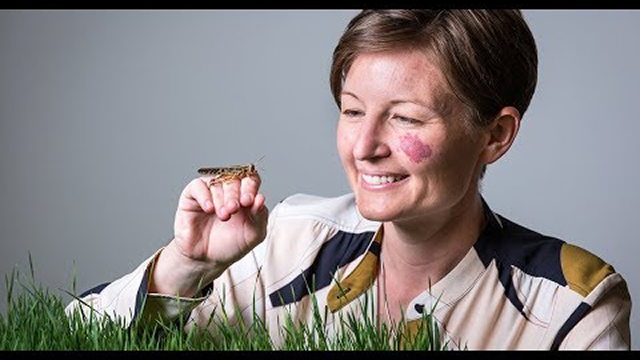Arianne Cease: Hi. My name is Arianne Cease. I’m faculty in the School of Sustainability and the Founding Director of the Global Locust Initiative at ASU.
I was first exposed to grasshoppers as a young farmgirl. I grew up on a ranch in southern Oregon, with pastures tucked into mountains amidst oaks and evergreens. I remember riding on the front bucket of the tractor through our grazing fields, and seeing grasshoppers covering the ground and jumping everywhere. They competed with our livestock for grass, but I was most interested in them as food for the pet praying mantises that my brother and I would catch.
While my parents chose the ranching lifestyle, I didn’t understand the value of being a steward of the land or growing your own food. I vowed to move to a big city, and I didn’t foresee another ranch or farm in my future. I wanted to see the world, and college was my ticket. I was captivated by biology, but after graduating I still wanted to travel and understand other places and cultures.
So I joined the Peace Corps. I arrived in the hot, sandy interior of Senegal as a sustainable agroforestry extension agent in 2005. I lived in a small subsistence farming village next to a towering baobab tree grove. Come the dry season, tree locusts descended on the village. They seemed to appear from nowhere and they covered everything; gardens, trees, millet stalk fences. I watched as villagers tried to protect the trees and gardens with machetes or pesticides. It was futile. In the end, the locusts ate everything, even the bark off the trees.
All locusts are grasshoppers, but not all grasshoppers are locusts. Locusts are grasshoppers that when exposed to specific environmental cues will form mass migrations and become a continental-level challenge. The immediate impacts of locusts on agriculture are obvious. For example, the desert locust plague in Western and Northern Africa that occurred between 2003 to 2005 cost an estimated 2.5 billion US dollars in crop losses.
However, perhaps the more profound impacts are long-term effects on livelihoods. For example, a study in Mali found that children born during locust plague years in villages impacted by locusts were much less likely to ever start school relative to children born in villages not impacted by locusts. The effect was greatest for young women.
Even after I left Senegal and started graduate school, I couldn’t forget the locust-caused decimation, the effect on farmers and families. I wanted to understand what caused locust outbreaks, and what could be done to decrease the impacts or to prevent them. This was a major factor that led me to China to study the Mongolian locust, supported by an NSF fellowship.
Initially, I thought the factors driving locust outbreaks would be solely environmental. However, it soon became clear that there was a strong human element. We would only find Mongolian locust outbreaks in fields heavily grazed by livestock. Puzzlingly, the locusts would ignore the lush green grass on the other side of the livestock fence. And we couldn’t understand why.
We thought it might have something to do with the nutrient content of the grass. Classically, herbivores prefer nitrogen-rich grasses. But we found that the grass in heavily-grazed fields had a lower nitrogen content. Overgrazing leads to loss of the topsoil, loss of organic nitrogen, and plants with a lower nitrogen content. Because nitrogen in plants is mostly found in the form of protein, that means plants with a low protein and high carbohydrate content. So feasting on overgrazed fields was like eating a doughnut diet for the locusts.
And what our research showed is that Mongolian locusts don’t just love the doughnut diet, they thrive on it. This helped explain why heavy livestock grazing led to locust outbreaks. The grazing was creating a nutritionally optimal niche for the locusts. And, when eating their doughnut diet, the locusts were more likely to migrate. This means that soil degradation was not only promoting locust outbreaks locally, but also migratory swarms. We went on to test this connection between land use and locust plagues in Australia, Senegal, and more recently Argentina and Bolivia. In each place, we’re finding that these different locust species prefer the low-protein, high-carbohydrate doughnut diet.
After finding the connection between land use and locust outbreaks, I brought together a team of researchers across disciplines, from economics to geography and food security, to understand the broader socioecological system around locust outbreaks. The Global Locust Initiative allows us to link our collective knowledge and resources. And by taking this integrative approach, we can work together to find solutions that consider multiple outcomes, including increasing farmer livelihoods, landscape sustainability, in addition to keeping locusts at bay.
Going into the Peace Corps and then working at ASU made me realize that science and sustainable development don’t have to be separate paths. By blurring these lines, I was able to return with a team to the region where I lived as a Peace Corps volunteer, partner with the national plant protection agency, local farming groups, and together work toward solutions.
When I left my childhood ranch, I thought I was leaving agriculture behind. Now I work with farmers all over the world. And I understand how critical they are as stewards of the land, and producers. My access to education led me to be able to develop the Global Locust Initiative. My hope is that our research can increase access to education and improve livelihoods for people growing up and living in locust-prone areas around the world. Thank you.
